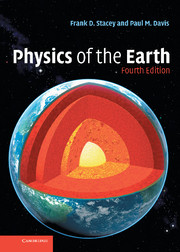Book contents
- Frontmatter
- Contents
- Preface
- 1 Origin and history of the Solar System
- 2 Composition of the Earth
- 3 Radioactivity, isotopes and dating
- 4 Isotopic clues to the age and origin of the Solar System
- 5 Evidence of the Earth's evolutionary history
- 6 Rotation, figure of the Earth and gravity
- 7 Precession, wobble and rotational irregularities
- 8 Tides and the evolution of the lunar orbit
- 9 The satellite geoid, isostasy, post-glacial rebound and mantle viscosity
- 10 Elastic and inelastic properties
- 11 Deformation of the crust: rock mechanics
- 12 Tectonics
- 13 Convective and tectonic stresses
- 14 Kinematics of the earthquake process
- 15 Earthquake dynamics
- 16 Seismic wave propagation
- 17 Seismological determination of Earth structure
- 18 Finite strain and high-pressure equations of state
- 19 Thermal properties
- 20 The surface heat flux
- 21 The global energy budget
- 22 Thermodynamics of convection
- 23 Thermal history
- 24 The geomagnetic field
- 25 Rock magnetism and paleomagnetism
- 26 ‘Alternative’ energy sources and natural climate variations: some geophysical background
- Appendix A General reference data
- Appendix B Orbital dynamics (Kepler's laws)
- Appendix C Spherical harmonic functions
- Appendix D Relationships between elastic moduli of an isotropic solid
- Appendix E Thermodynamic parameters and derivative relationships
- Appendix F An Earth model: mechanical properties
- Appendix G A thermal model of the Earth
- Appendix H Radioactive isotopes
- Appendix I A geologic time scale
- Appendix J Problems
- References
- Name Index
- Subject Index
5 - Evidence of the Earth's evolutionary history
Published online by Cambridge University Press: 05 July 2013
- Frontmatter
- Contents
- Preface
- 1 Origin and history of the Solar System
- 2 Composition of the Earth
- 3 Radioactivity, isotopes and dating
- 4 Isotopic clues to the age and origin of the Solar System
- 5 Evidence of the Earth's evolutionary history
- 6 Rotation, figure of the Earth and gravity
- 7 Precession, wobble and rotational irregularities
- 8 Tides and the evolution of the lunar orbit
- 9 The satellite geoid, isostasy, post-glacial rebound and mantle viscosity
- 10 Elastic and inelastic properties
- 11 Deformation of the crust: rock mechanics
- 12 Tectonics
- 13 Convective and tectonic stresses
- 14 Kinematics of the earthquake process
- 15 Earthquake dynamics
- 16 Seismic wave propagation
- 17 Seismological determination of Earth structure
- 18 Finite strain and high-pressure equations of state
- 19 Thermal properties
- 20 The surface heat flux
- 21 The global energy budget
- 22 Thermodynamics of convection
- 23 Thermal history
- 24 The geomagnetic field
- 25 Rock magnetism and paleomagnetism
- 26 ‘Alternative’ energy sources and natural climate variations: some geophysical background
- Appendix A General reference data
- Appendix B Orbital dynamics (Kepler's laws)
- Appendix C Spherical harmonic functions
- Appendix D Relationships between elastic moduli of an isotropic solid
- Appendix E Thermodynamic parameters and derivative relationships
- Appendix F An Earth model: mechanical properties
- Appendix G A thermal model of the Earth
- Appendix H Radioactive isotopes
- Appendix I A geologic time scale
- Appendix J Problems
- References
- Name Index
- Subject Index
Summary
Preamble
Although we believe that the terrestrial planets all have essentially the same major chemical constituents, the atmospheres, where they exist, are very different (Tables 2.8 and 2.9). This diversity means that atmospheric composition is a sensitive indicator of the evolutionary history of the planets. The radiogenic isotope 40Ar, being a decay product of 40K, is of particular interest to the Earth as a whole because it would have been very rare indeed when the Earth first formed, and has leaked to the atmosphere progressively over the life of the Earth. We suppose that the potassium abundances of Venus, Earth and Mars are similar, an assumption justified for Venus by data plotted in Fig. 21.1. Then the three-fold greater value of the ratio mass of atmospheric 40Ar to mass of planet for the Earth than for Venus shows that the leakage of 40Ar to the atmosphere has been much more effective for the Earth. This requires the convective stirring of the Earth to have been more vigorous.
We also need to explain the fact that the ratio 36Ar/40Ar for Venus is 270 times the terrestrial value. We can be confident that in all cases the 40Ar was produced in the planets after they formed, but that 36Ar was either inherited from the solar nebula or was acquired subsequently from the solar wind. Solar Ar is dominated by 36Ar.
- Type
- Chapter
- Information
- Physics of the Earth , pp. 72 - 80Publisher: Cambridge University PressPrint publication year: 2008



